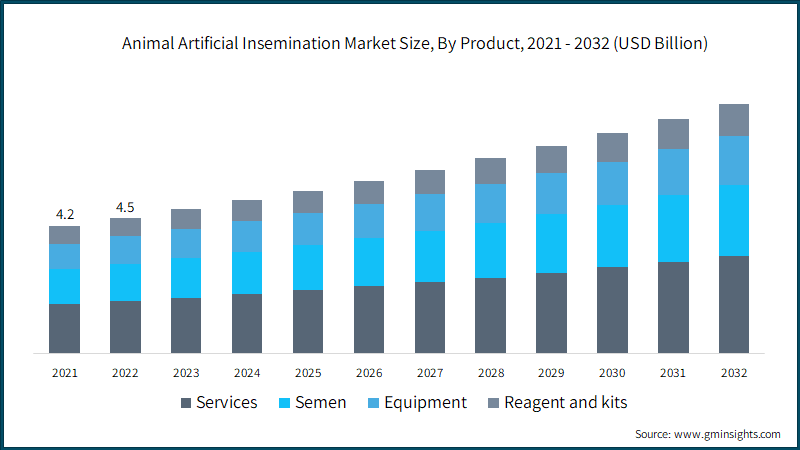Home > Animal Health & Nutrition > Veterinary Services > Animal Artificial Insemination Market
Animal Artificial Insemination Market Analysis
- Report ID: GMI6482
- Published Date: Aug 2023
- Report Format: PDF
Animal Artificial Insemination Market Analysis
Based on product, the animal artificial insemination market is segmented as services, equipment, semen, and reagent & kits. The semen segment further divided into normal semen and sexed semen. In 2022, the services segment accounted for most of the market share due to the increased adoption of services. These constitute AI service execution, reproduction management, sperm assessment and analysis, genetic consults, and training and education. Additionally, artificial insemination procedures require specialized knowledge and skills. Veterinarians, reproductive specialists, and trained technicians provide these services. As the complexity of breeding techniques increases, the demand for professionals with expertise in reproductive sciences grows.
Based on animal type, the animal artificial insemination market is segmented as bovine, swine, ovine & caprine, equine, and other animal types. The bovine held a dominant market share of around 40% in 2022 and is expected to grow at a significant pace during the analysis period. Bovine artificial insemination enhances breeding efficiency by eliminating the demand for natural mating and lowering the danger of harm to both animals and humans. It also increases the number of cows for whom a single bull's sperm may be utilised, enhancing total breeding output. In addition, artificial insemination reduces the risk of sexually transmitted diseases that can be spread through natural mating. This contributes to better biosecurity practices and disease prevention within cattle herds, hence leading to the segment progress.

Based on technique, the animal artificial insemination market is segmented as intrauterine tub peritoneal insemination, intracervical insemination, intrauterine insemination, and intratubal insemination. The intratubal insemination segment is expected to grow at a significant pace of 6.5% between 2023 to 2032. Intratubal insemination allows semen to be delivered directly into the uterine tube, closer to the site of fertilisation. As the sperm cells have a shorter distance to travel to contact the egg, the probability of successful fertilisation increase, which will led to increase the demand for segment growth.
Based on end-user, the animal artificial insemination market is segmented as veterinary hospitals, veterinary clinics, and other end-users. The veterinary hospitals segment held a dominant market share of 51.7% in 2022 and is expected to grow at a significant pace between 2023 to 2032. Veterinary hospitals are equipped to assess and manage the reproductive health of animals. These professionals can identify potential issues that might affect fertility, provide advice on enhancing fertility rates, and address any reproductive health challenges. Moreover, veterinary hospitals often have access to advanced reproductive technologies and equipment that may not be available on farms or smaller facilities. This allows for the use of cutting-edge techniques and tools to enhance the success rates of artificial insemination.

North America animal artificial insemination market accounted for the largest share of 38.8% in 2022 and is anticipated to grow at 6.4% during the forecast timeframe. North America has a highly developed and efficient livestock firm, which includes the production of dairy, beef, swine, and poultry. The use of artificial insemination services is driven by a need for high-quality genetics, increased productivity, and enhanced breeding outcomes.
Furthermore, North America is at the forefront of technological advancements in animal agriculture. The region benefits from the latest reproductive technologies, synchronization protocols, and semen processing techniques that enhance the success rates of artificial insemination, leading to the regional growth.

